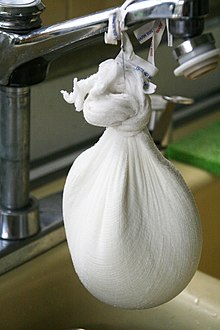Cheesecloth
A cheesecloth , muslin , cloth strainer , Koliertuch or cheese cloth is a thin, wide-mesh woven cloth made of cotton , which in the kitchen for straining and for cheese production is used.
use
Preparation of food

Cheesecloths are mainly used in cheese making . The cloth serves to separate the curd from the whey and hold the curd together. The dairy products made in this way include queso blanco , quark and panir .
In addition, cheesecloths are used to strain the stock and English cream , to thicken yoghurt , and to make tofu , ghee and alcohol-soaked fruit cakes. Cheesecloths are also used to separate liquids from very small solids. For example, the soaking water from dried mushrooms , which should be used as an additional "flavor carrier" after the mushrooms have been removed, can be cleaned of sand and similar fine components with a cheesecloth.
The press sack , which is used to squeeze grated potatoes, works in a similar way .
Other uses
Cheesecloths are also used in various printing techniques . In lithography , they are used to wipe up the gum arabic , and in the intaglio , a starched cheesecloth (“ tarlatan ”) is used to wipe off excess ink.
Summer shirts are also made from cheesecloth fabric in India and Pakistan. Such shirts were popular as beach wear in the United States in the 1960s and 70s.
Grade
The fineness of the fabric of cheesecloths is given in one of seven degrees, depending on the number of threads per unit length.
| Degree | Vertical × horizontal threads | |
|---|---|---|
| per inch | per cm | |
| # 10 | 20 × 12 | 8 × 5 |
| # 40 | 24 × 20 | 9.5 × 8 |
| # 50 | 28 × 24 | 11 × 9.5 |
| # 60 | 32 × 28 | 12.5 × 11 |
| # 90 | 44 × 36 | 17.5 × 14 |
Individual evidence
- ^ The Care And Feeding Of A Fruitcake . Archived from the original on March 7, 2016. Retrieved March 3, 2016.
- ^ Romano Ross: The Complete Printmaker , pp. 114, 118. TheFreepress, 1990
- ^ Clothes of the Seventies, Cheese Cloth Shirts . Inthe70s.com. Retrieved December 7, 2011.
